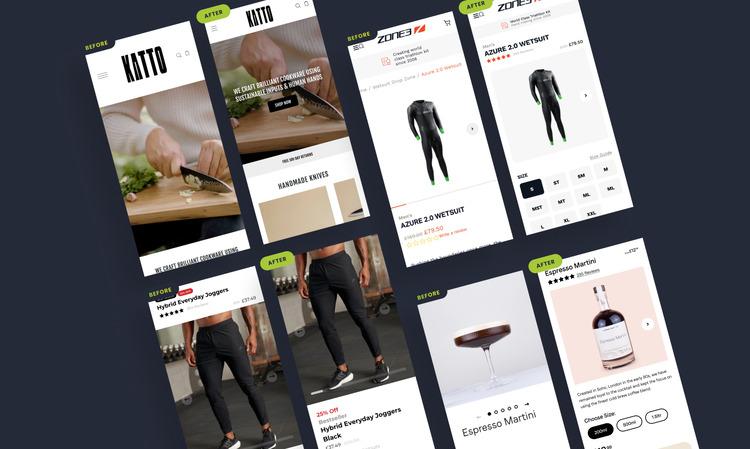When it comes to running an ecommerce business, understanding customer behaviour is paramount to success.
As an ecommerce manager, marketing executive or business owner, you’ll likely be familiar with your website’s analytics. Whilst keeping an eye on your site’s organic traffic, sessions and conversions is essential, understanding your bounce rate is often overlooked. Reducing your website’s bounce rate can have a significant impact on the success of your brand as you can implement simple yet effective changes to stop users leaving your ecommerce website and drive more sales. Still not convinced? Read on to find out more…
What Is Bounce Rate?
Firstly, understanding the meaning of bounce rate is key. Put simply, bounce rate describes the number of visitors who leave your website after only visiting one page. So why is this so bad for your business? Well, if a site visitor is exiting your site after visiting just one page, it could indicate that they haven’t found what they’re looking for after landing on your site, your site may be offering a subpar user experience or perhaps your content isn’t what they were expecting. For ecommerce brands, bounce rate is a crucial metric to track because the longer a user stays on your site, the more likely they are to checkout. Now you understand the importance of reducing bounce rate, here are our top tips for improving this metric to drive growth for your brand:
1. Optimise Page Speed
When a visitor lands on your ecommerce website, they expect instant access to the information they’re seeking. If your pages take too long to load, users are more likely to abandon your site altogether, resulting in a higher bounce rate. Studies have shown that even a mere one-second delay in page load time can lead to a significant increase in bounce rate. Therefore, prioritising page speed when you’re updating your website and adding content is paramount to success. Here are a few ways you can optimise page speed:
- Optimise images: Ensure that your image dimensions are optimised and that file sizes aren’t too large to prevent slow-loading that could interrupt the user experience.
- Minify code: Minifying code will ensure that your website isn’t slowed down by complex CSS, HTML and JS files
- Use a CDN: A content delivery network helps to reduce file size and increase site speed.
- Choose a reliable server: Ensure that you choose a reliable server that can withstand surges in traffic and provides lightning-fast operation.
- Browser caching: Browser caching reduces the amount of data transferred between the server and browser and as a result, improves your website’s speed.
2. Craft Compelling & Relevant Content
Another reason that users abandon a website is due to low-quality content. Relevant and engaging content not only satisfies the immediate informational needs of visitors but also establishes your brand as a trusted authority in your industry. It can capture visitors’ attention, foster emotional connections and encourage prolonged interaction with your website. By prioritising the creation of compelling and genuinely interesting content that is targeted to your unique audience, you can effectively keep visitors on your site longer, increase their likelihood of converting and ultimately drive. Here are a few tips for crafting great content:
- Utilise storytelling: Storytelling is a powerful tool that can take your content to the next level. When crafting your about page, product descriptions or blog posts, tell the story of your products and brand and utilise storytelling to highlight why a customer needs your product to elevate their life! Ensuring that your content resonates with your audience is key to keeping them engaged and browsing your website.
- Target your audience: It may be obvious but it’s all too often overlooked. Ensure that you are crystal clear on who your target audience is and tailor your content specifically to their needs. Adapt your tone of voice accordingly and you’ll be on your way to building key relationships and trust with your prospect customers.
- Craft clear product descriptions: Clear product descriptions that are laid out in a visually pleasing and easy-to-digest format will provide users with the information they need to make an informed decision and will encourage them to compare products and continue browsing on your website.
- Add visual elements: Visual elements within your content can enhance and strengthen your messaging whilst capturing your audience’s attention so be sure to incorporate original graphics and creative product photography where relevant.
3. Enhance The User Experience
In 2024, users are more discerning than ever before when it comes to user experience. Providing an intuitive, streamlined and seamless online experience is absolutely paramount for reducing your bounce rate and encouraging users to stay on your site. A user-friendly design not only ensure an effortless shopping experiences, but also instils confidence and trust in your brand. Visitors are more likely to stay and interact with your content, products and services when they can navigate your site easily and find what they’re looking for quickly. By prioritising user-friendly design principles, you can create a positive browsing experience that encourages visitors to linger, explore further and convert into customers. Here are a few ways you can enhance UX for your website:
- Ensure clear call-to-actions: Clear call-to-actions (CTAs) are a brilliant way to keep users on your website. By utilising a contrasting colour for your CTA buttons combines with persuasive copy, you’ll encourage users to explore your website further and get lost in all of the exciting products and content you have to offer!
- Implement hierarchical navigation: Hierarchical navigation is a game-changer for ecommerce websites as it makes the user experience so much smoother as customers can quickly and easily find the product or category they’re searching for. A seamless shopping experience will not only keep users on your site for longer (increasing the likelihood of conversion) but also keep them coming back for more.
- Utilise responsive design: Responsive design is integral to reducing bounce rate as most users access the web from mobile devices these days. If your site isn’t optimised for mobile, you’re likely to lose valuable customers.
- Prioritise accessibility: Accessible design is paramount to reducing bounce rate as it ensures that your site is easily digestible and inclusive for everyone who lands on your site.

4. Implement Exit-Intent Popups
Exit-intent popups are a type of overlay or modal window that is triggered when a visitor exhibits intent to leave a website, typically indicated by moving their cursor towards the browser’s navigation bar or closing the tab/window. These popups are designed to intercept the visitor’s exit attempt and present them with a targeted message, offer, or incentive in a last-ditch effort to retain their attention and prevent them from bouncing off the site. By strategically deploying exit-intent popups, ecommerce websites can capture departing visitors’ attention, re-engage them with compelling offers or content, and potentially convert them into leads or customers, thereby reducing bounce rate and maximising conversion opportunities.
5. Utilise A/B Testing
A/B testing, also known as split testing, is a methodical approach used by ecommerce brands to compare two or more versions of a website element to determine which one performs better in terms of reducing bounce rate and improving user engagement. By systematically testing different variations of website elements, such as headlines, images, layout, or CTA buttons, ecommerce businesses can identify the most effective design, content and functionality that resonates with their target audience and drives desired outcomes. A/B testing provides valuable insights into visitor behaviour, preferences and motivations, enabling data-driven decision-making and continuous optimisation of website elements to minimise bounce rate and maximise conversion opportunities. Oftentimes, ecommerce and marketing managers may need a helping hand to ensure their A/B tests are optimised. If this is you, don’t hesitate to reach out!
Understanding customer behaviour is crucial for ecommerce success, and reducing bounce rate plays a pivotal role. By optimising page speed, crafting compelling content, enhancing user experience, implementing exit-intent popups and utilising A/B testing, ecommerce businesses can retain visitors, drive engagement and ultimately increase conversions. These strategies ensure a seamless and engaging browsing experience, encouraging users to explore further and ultimately contribute to the long-term success of your business.
Need a helping hand with reducing the bounce rate of your ecommerce website? Don’t hesitate to get in touch!







